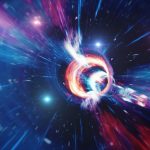Key takeaways
- Researchers observed events in gamma-ray bursts that appear to repeat as if moving backward in time.
- A new study suggests that waves within relativistic jets of gamma-ray bursts moving faster than light could cause this effect.
- These powerful explosions can result from colliding neutron stars or massive stars collapsing into black holes, ejecting material at high speeds.
- Jets from black holes, surrounded by accretion material, can create gamma-ray bursts when they interact with the progenitor star’s outer layers.
- Similar to Cherenkov radiation, superluminal waves in gamma-ray bursts might produce a ‘luminal boom,’ creating time-forward and time-reversed light curve features.
As far as we know, time can only move in one way. However, researchers discovered events in some gamma-ray burst pulses that appeared to repeat themselves as if they were moving backwards in time.
Recent research gives a possible explanation for what is producing the temporal reversibility effect. If waves within the relativistic jets that cause gamma-ray bursts move faster than light – at’superluminal’ speeds – one of the consequences could be time reversibility.
Recent research gives a possible explanation for what is producing the temporal reversibility effect. If waves within the relativistic jets that cause gamma-ray bursts move faster than light – at’superluminal’ speeds – one of the consequences could be time reversibility.
As a result, a wave might travel through a gamma-ray burst jet at superluminal speeds without violating relativity. To comprehend this, we need to take a step back and look at the source of the jets.
Gamma ray bursts are the most powerful explosions in the universe. They can last anywhere from a few milliseconds to several hours, are extremely bright, and there is no definitive explanation for why they occur.
Observations of colliding neutron stars revealed that these collisions can produce gamma-ray bursts. Astronomers believe such bursts occur when a big, fast rotating star falls into a black hole, aggressively ejecting material into the surrounding space in a colossal hypernova.
That black hole is then surrounded by a cloud of accretion material around its equator; if it rotates quickly enough, the fallback of the initially exploded material causes relativistic jets to emerge from the polar regions, blasting through the progenitor star’s outer envelope before producing gamma-ray bursts.
Now, back to those waves that travel faster than light.
We know that when particles go across a medium, they can move faster than light. This phenomenon is responsible for the well-known Cherenkov radiation, which appears as a unique blue glow. A ‘luminal boom’ occurs when charged particles, such as electrons, move faster through water than light’s phase velocity.
Astrophysicists Jon Hakkila of the College of Charleston and Robert Nemiroff of Michigan Technological University believe that the same phenomenon may be seen in gamma-ray burst jets, and they have used mathematical modeling to show how.
“In this model an impactor wave in an expanding gamma-ray burst jet accelerates from subluminal to superluminal velocities, or decelerates from superluminal to subluminal velocities,” according to the study they wrote.
“When the impactor wave travels faster than the speed of light in this medium, it interacts with the surrounding medium to produce Cherenkov and/or other collisional radiation, and when it travels slower, it produces other mechanisms (such as thermalised Compton or synchrotron shock radiation).
“These transitions produce both a time-forward and a time-reversed set of [gamma-ray burst] light curve features through the process of relativistic image doubling.”
Such relativistic picture doubling is thought to occur in Cherenkov detectors. When a charged particle traveling at near-light speed reaches water, it moves faster than the Cherenkov radiation it emits, and hence can appear to be in two places at once: one picture moving forward in time and the other moving backwards.
However, this doubling has not yet been experimentally observed. However, if it does occur, it may also be responsible for the time-reversibility observed in gamma-ray burst light curves, which occurs when the impactor wave traveling through the jet medium accelerates to speeds faster than light and decelerates to subluminal speeds.
Obviously, more effort is required. The researchers hypothesized that the impactor responsible for generating a gamma-ray burst would be a large-scale wave caused by changes in density or magnetic field. That will require further investigation. And if the plasmas in question are not transparent to superluminal radiation, all bets are off.
However, the researchers stated that their model better explains the properties of gamma-ray burst light curves than models that do not contain time reversibility.
“Standard gamma-ray burst models have neglected time-reversible light curve properties,” Hakkila pointed out. “Superluminal jet motion accounts for these properties while retaining a great many standard model features.”
The research has been published in The Astrophysical Journal.


